We occasionally link to goods offered by vendors to help the reader find relevant products. Some of these may be affiliate based, meaning we earn small commissions (at no additional cost to you) if items are purchased. Here is more about what we do.
There are so many practical everyday uses for grapeseed oil in your kitchen!
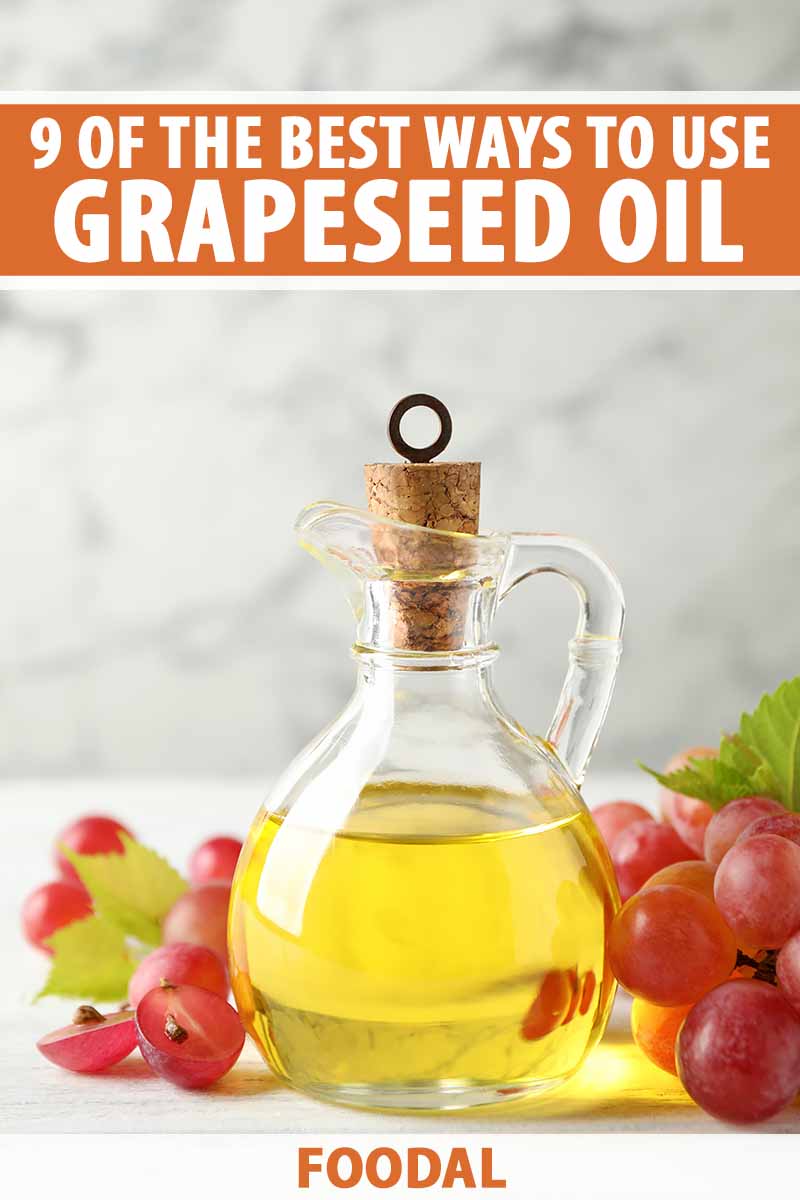
Grapeseed oil is extracted from grape seeds, most often as a byproduct of the winemaking process.
Unlike other cooking fats with strong aromas and flavors, the liquid extracted from grape seeds does not taste like grapes, grape juice, or wine – it’s actually clean and mild.
Think of how peppery and biting olive oil can potentially be, or how intoxicatingly aromatic peanut oil is when used in a deep-fryer!
Grapeseed oil’s neutral aroma and flavor, as well as its higher smoke point, makes it an approachable and versatile fat for both cooking and baking.
With a smoke point between 390 and 420°F, this fat can be used for many cooking applications that utilize high heat without compromising the flavor integrity of whatever you’re preparing.
It’s a highly popular choice among chefs and bakers, securing its place in professional restaurant and bakery settings as well as in the kitchens of many home cooks.
If you are new to using grapeseed oil, and still need a little more convincing before you buy a bottle or canister, learn about nine different ways you can use this multipurpose ingredient in your daily cooking and baking.
You’ll be persuaded soon enough!
9 of the Best Ways to Use Grapeseed Oil in Your Cooking
1. Baking
If you are looking for a small yet impactful change from your typical vegetable or canola opttions in your baking recipes, switch to grapeseed instead.
Two-time James Beard Award winner Christina Tosi, chef and founder of the Milk Bar empire, recommends grapeseed oil for all of her baking recipes.
Praising its viscous consistency, effective emulsification properties, and incredibly clean and mild flavor, Tosi lists it as a fundamental ingredient in her first cookbook, “Momofuku Milk Bar.” It’s available to purchase from Amazon.
And you should treat it with the same accolades in your own kitchen, fellow bakers!
Substitute an equal amount of grapeseed oil for vegetable or canola in your recipes – try this switch in our zucchini bread, vegan vanilla coconut cupcakes, and chocolate raspberry cream sandwich cookies.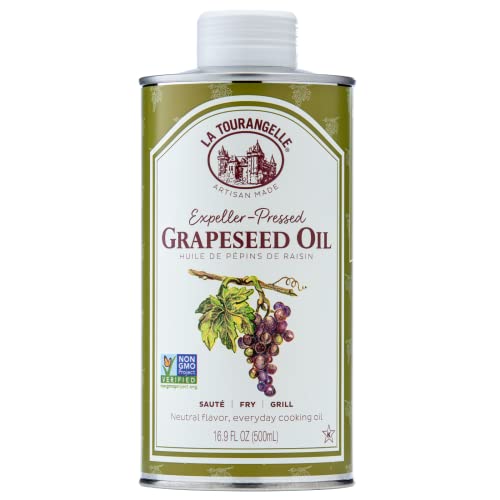
La Tourangelle Grapeseed Oil, 16.9 ounces, available from Amazon
If you need a quick product recommendation, purchase this 16.9-ounce canister from La Tourangelle, available now from Amazon.
2. Deep Frying
Grapeseed oil can be suitable for deep fat frying applications, with a few caveats to carefully consider.
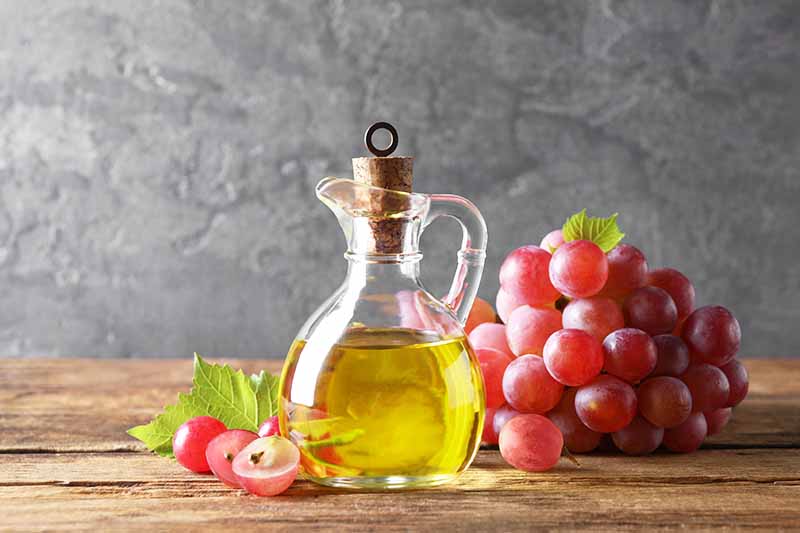
Light in flavor with the ability to withstand high heat, it is wonderful for deep frying or pan frying – but this fat barely crosses the line to meet Foodal’s recommended minimum smoke point for deep-frying of 400°F.
According to Harold McGee in his book “On Food and Cooking: The Science and Lore of the Kitchen,” grapeseed oil is composed of a significantly higher percentage of polyunsaturated fatty acids compared to saturated fatty acids and monounsaturated fatty acids. With multiple bonds, polyunsaturated fatty acids have a greater risk of breaking down and become acrid at prolonged higher temperatures.
For a deeper understanding of the scientific composition of fats, you can purchase McGee’s book from Amazon now.
Use grapeseed oil when you are deep frying or pan frying foods that do not require a long cooking time. We also recommend using it for smaller servings of food, so you don’t expose it to high temperatures for multiple batches over an extended period of time.
This would be ideal for frying fish as well as vegetables, such as vegan jalapeno poppers and avocados fries.
Though we do suggest using an oil with a higher smoke point for your coveted fried chicken recipe!
3. Dressing
Grapeseed oil is adaptable in no-cook preparations, and its neutral base is an essential fatty foundation for different styles of dressings and condiments to beautifully adorn your salads or spread on your sandwiches.

Use it instead of extra virgin olive oil in our creamy honey balsamic dressing or lemon tarragon pesto dressing.
You can also use it as the base for a homemade herb-infused oil, or to make homemade mayonnaise.
4. Grilling
Use it to lightly coat anything you’ll be grilling for your next barbecue if you don’t want stronger-flavored fats getting in the way of your deliciously crafted outdoor dinner plans.
A thin layer on salmon fillets, lobster tails, and flatbread pizzas will prevent them from sticking to the grates.
It also makes a great addition to sauces and marinades for foods destined to be cooked on the grill. We’d love for you to use it in our marinated tri-tip steak recipe, for example!
5. Roasting
As effortless and thoughtless as breathing, many of us innately grab the bottle of olive oil to drizzle a hearty tablespoon or two over our meats and veggies for roasting.
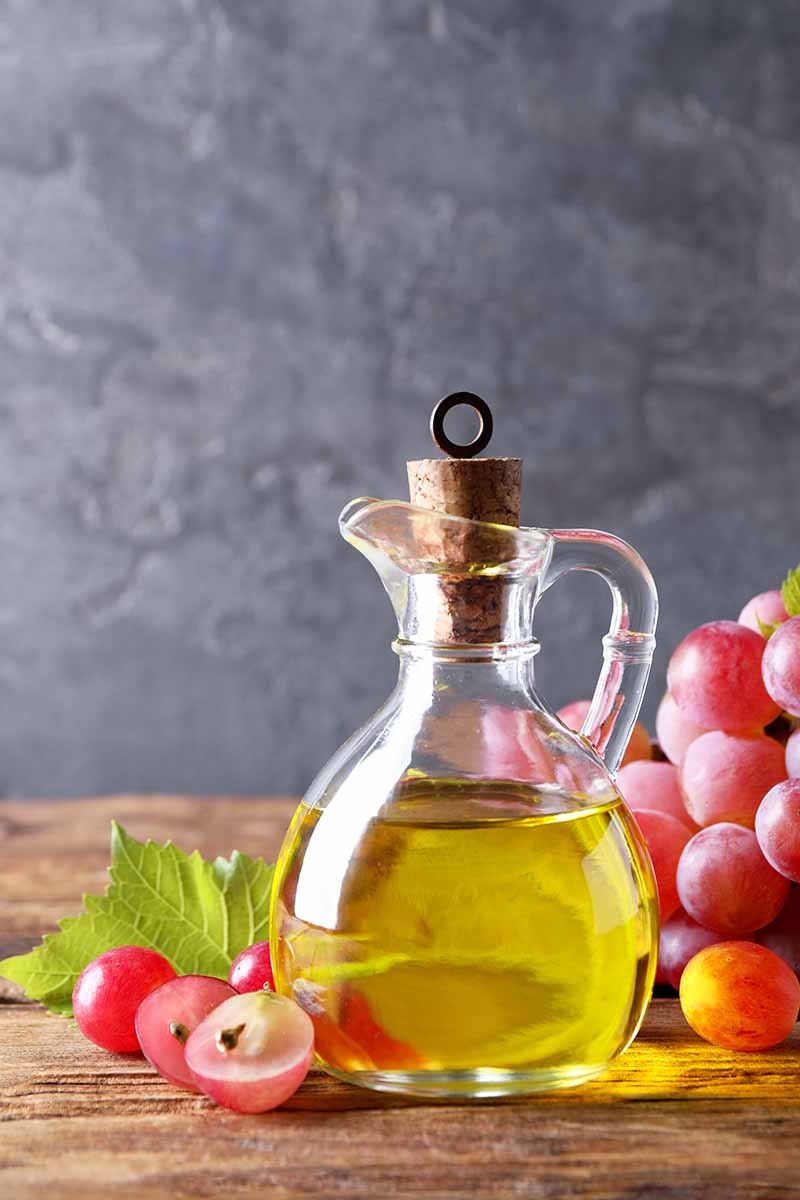
It’s our usual choice, too!
But consider using the grapeseed variety when you want the garden-fresh flavors of your home-harvested vegetables, or the terroir-driven taste of locally sourced livestock, to really sing without the intrusion of a more flavorful fat.
Try it the next time you’re able to buy a high-quality pork roast to prepare to perfection in the pressure cooker, or when you’re roasting a medley of the most vibrant fall vegetables.
6. Sauteing
Sauteing is grapeseed oil’s true happy place!
Its light flavor and high smoke point allows you to saute the day away, freeing you to cook a variety of recipes while letting the main ingredients be the star of the show.
As an example, you’ll be able to really taste the fresh greens in our sauteed Swiss chard recipe by using grapeseed instead of olive oil!
7. Searing
Because of its ability to quickly reach high temperatures, attaining a hard sear and a browned, crisp crust on your food items will be easy with this lovely, liquidy ingredient.
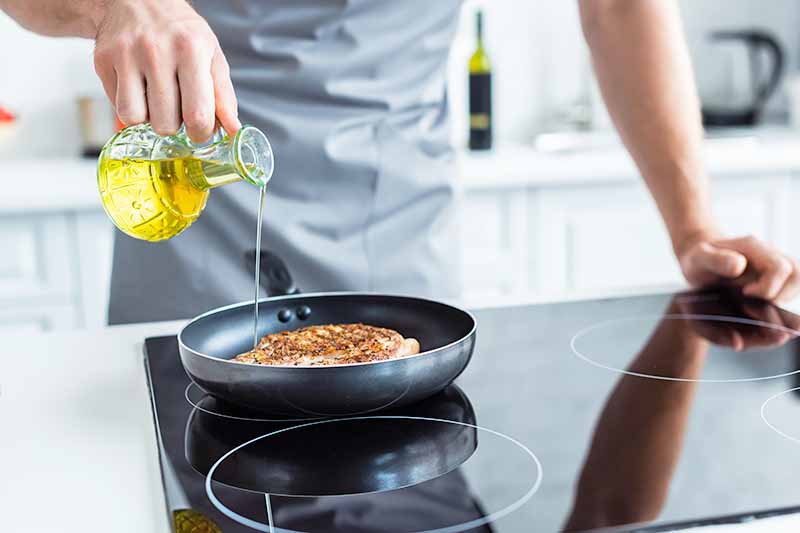
Whether you finish your dish on the stovetop or in the oven, you will achieve caramelized perfection with your restaurant-quality steaks, marinated chicken breasts, and more.
8. Stir Frying
Perfect for rapid stir-frying applications, use grapeseed oil when you want a neutral option for sizzling in a hot wok.
It will allow the vibrancy and freshness of quickly cooked vegetables and meats to shine through, while remaining a neutral foundation for strongly flavored sauces.
Reach for this fat the next time you make our chicken and shrimp lo mein or cabbage stir fry.
9. Stretching
Are you down to the last few tablespoons of your favorite – and very expensive – extra virgin olive or nut oil?

Temporarily stretch out its life and usage by combining the rest with a few teaspoons of grapeseed oil.
We wouldn’t recommend doing something like this on a regular basis, but this is a quick fix for every now and then when you find yourself just a little short of what you need for a recipe that you’re in the middle of making.
Neutral grapeseed will not clash with the stronger fats, though it will slightly dilute them.
Go for Grape
The next move is yours – bring grapeseed oil along on your next culinary journey!

There’s nothing to be nervous about with this purchase. A multipurpose oil will be a most welcome addition to your other cooking fats.
Not only will it feel right at home with your other pantry staples, it will also blend seamlessly into your cooking and baking styles.
Customize its use however you need: you won’t have to break your usual stride of baking batches of cookies and quick breads, grilling steaks and seafood, and sauteing and stir frying your next quick meal.
Grapeseed oil will be able to do it all!
What recipe do you have in mind to use it in first? Ideas are always appreciated in the comment section below.
Are there other ingredients that have piqued your curiosity? We have the information you need to learn more. Gain even more cooking knowledge with these suggested reads:
- Add Edible Flowers to Your Cooking
- 19 Flour Types for Gluten-Free Baking
- 9 Types of Aromatic Mint for Garnishes and More
© Ask the Experts, LLC. ALL RIGHTS RESERVED. See our TOS for more details. Uncredited photos via Shutterstock. Product photo via Amazon. Originally published by Marla Tetsuka on February 10, 2016. Last updated on August 23, 2023.
About Nikki Cervone
Nikki Cervone is an ACS Certified Cheese Professional and cheesemonger living in Pittsburgh. Nikki holds an AAS in baking/pastry from Westmoreland County Community College, a BA in Communications from Duquesne University, and an MLA in Gastronomy from Boston University. When she's not nibbling on her favorite cheeses or testing a batch of cupcakes, Nikki enjoys a healthy dose of yoga, wine, hiking, singing in the shower, and chocolate. Lots of chocolate.

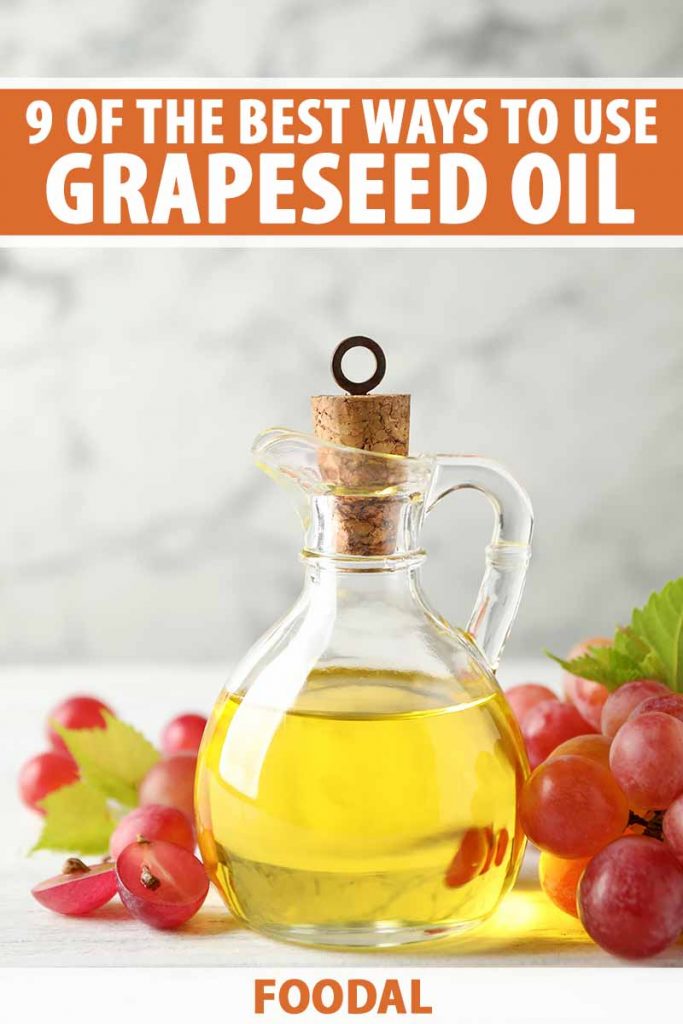



I had no idea that grapeseed oil could be used like any other cooking oil. I have a feeling that it is crazy expensive though.
Its available at many price points. Take a quick look at Amazon to compare. Consider how you might use it. A drizzle for a crusty bread or a bit for a quick sauté is well worth the result you’ll achieve.
Out here in California it’s pretty cheap. It’s not as cheap as vegetable oil, but better than olive oil, which is surprising. It also has a really nice flavor, and I highly recommend it in place of olive oil for salads and roasted vegetables. I’ve also heard that it’s very heart healthy and better than vegetable oil for people who have diabetes. Hispanic or Mexican grocery stores often carry it for a good price.
I just now saw it on the Costco online site: Ottavio Grapeseed Oil, 68 fl. oz. $7.99 with a $3.00 delivery fee unless you combine it with other second-day delivery items to total $75.00 or more to qualify for free delivery. I usually use Costco’s avocado oil but that entails waiting until we make the 60-mile trek to the nearest Costco warehouse, since they don’t offer it online. Next time I do a second-day delivery order, I’m going to try this grapeseed oil. I like that it has a high smoke point. In any event, after reading more about canola oil I’m constantly on the lookout for alternatives. (The last straw was when I found out that one of the last processes to manufacture canola oil is to deodorize it so it doesn’t totally stink up the joint.)
I’m always looking for new ways to change up the way that I sear meat. Even the subtlest of changes can make a great deal of difference in taste in the meat. I never considered using grapeseed oil in salad dressing. I admit, that sounds a bit odd. However, you never know until your try. It’s worth a shot anyway. Thanks for the ideas!
Glad to hear from you! Yes, I agree searing meat is paramount in ensuring richness of flavor and juiciness. Besides, who doesn’t light up when they see that glorious color? Please don’t feel shy using it in you salad dressings. Your vinegars, citrus, mustards will come out being a star and so will you.
I’ve wondered about this type of oil before when I’ve seen it at the store but I’ve never wanted to take a chance on it. For some reason I was under the impression that it had a strong flavor or was only good for very particular types of cooking. I had no idea it could be used in such a wide variety of applications; I think I’ll pick some up next time I see it and give it a try 🙂 I’ve been wanting to try deep frying lately so this is the perfect opportunity!
Oh my gosh. I felt the same way until I took the leap and tried it out. There is no strong flavor, if a flavor at all. That’s what makes it so transparently fabulous. Your fresh flavors will shine through! Go ahead and try it out. I would suggest familiarizing yourself with using a bit at a time and then yes, go for deep frying. Let me know about your adventures.
I hope people have kept up with the latest studies. There’s a reason people spit the seeds of grapes out. They don’t taste very good at all. Bottled grapeseed oil doesn’t have flavour and odour. It takes a lot of processing to get it that way. Seed oils are not safe to cook with. They are as processed as vegetable and canola oils
Wow, that’s a lot of seeds to get a bottle of oil. My mom has always recommended that I have some in the kitchen, but I could never get over that price. I agree it is fantastic, but it just doesn’t really fit into my budget to use more often.
When I think about those little seeds…it is mind blowing to think it takes a ton of grapes to gather enough for a single bottle. My mom was always right (so she taught me) and she was a fabulous cook. Try pricing out different purchasing options at your local market or at amazon. A little drizzle can do wonders!
I just recently got into using this. I love it for frying different foods….I might like it a little better than peanut oil actually. It was introduced to me on a blog and it caught my eye because it seemed a bit more natural than the other oils I usually use. It is also good for a skin moisturizer and a bath oil…so I have used it for these purposes as well.
Wow! It’s inspiring to know that you have used it for deep frying. I am sure that you will encourage so many other Foodal readers who have been wondering about this. I’ll bet you have the best crispy crunch in town. And good for you for exploring its many other uses. Thanks for sharing.
To be honest I wasn’t sure about using this oil because of how it may taste. Now that I know it can be used in many other ways, I may try it, as I like to use different oils in pasta or noodle salads. I also like to roast vegetables with oil rather than butter, and maybe I could try it with potatoes?
This is a wonderful choice for roasting vegetables! You’ll really enjoy the fresh taste it brings out. Potatoes should work well too. Give it a try.
Only a few days ago I finally learned how essential oils were used, the variations and specifications of them, and still, I had no idea that grapeseed oil existed, and it seems such a long process for a small amount of money!
I really liked how you can basically make the best of it in a lot of different foods. The only thing that I didn’t like about the other oils is that they only had really limited use, mostly in deserts, and even if at the end of the day, it’s worth it, I still would prefer to have more variation, and this one feels perfect when it comes to that aspect.
Thanks for sharing!
1 ton of grapes = 1 bottle of grapeseed oil
How many ounces is the bottle?
Thanks for your question, John! Maybe this was a bit of an oversimplification on the part of the author. Nonetheless, since the oil comes from the seeds and is usually a byproduct of winemaking, it isn’t an exaggeration- about a ton of grapes is required to make one 8-oz bottle.
I love grapeseed oil. I prefer it over olive oil. I use it on a daily basis. I like because its flavor does not compete with the flavor you are cooking or adding on as flavoring to your recipe. It actually helps enhance the flavor of your dish. It is a little cheaper than olive oil and a little pricier than the vegetable oils, but worth every penny.
I was just wondering if I got a good deal on a 25.3 fl oz bottle of grapeseed oil I was able to purchase for $5.99?
Costco has the giant bottle for $7.00. The small bottle is over $7.00 in grocery stores. This oil is amazing.
I’ve been looking for a light tasting oil that isn’t overly industrially processed. Grapeseed oil is now going to be my go to oil.
How do you store grapeseed oil? Fridge?
Hi, Kay! Like most cooking oils, grapeseed oil is fine stored in a dry space at room temperature away from direct sunlight and away from any heat sources, like your stove. Heat, sunlight, and humidity all have a negative affect on cooking oils. I like to store my oils in a dark pantry, or on a shelf in a cupboard.
Thanks so much Marla, this article is so useful!